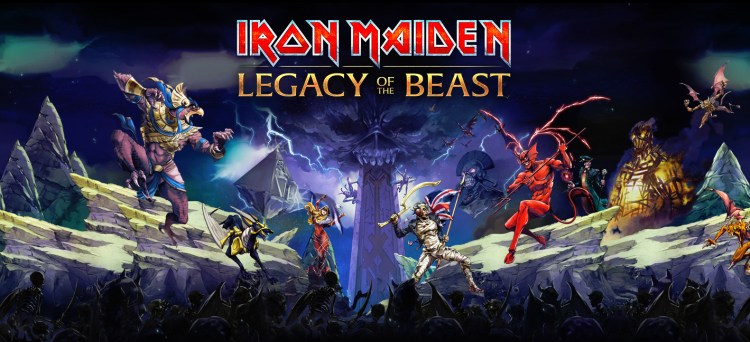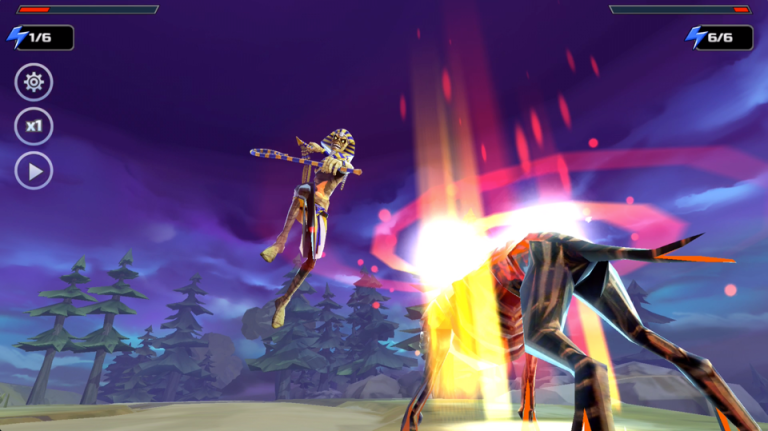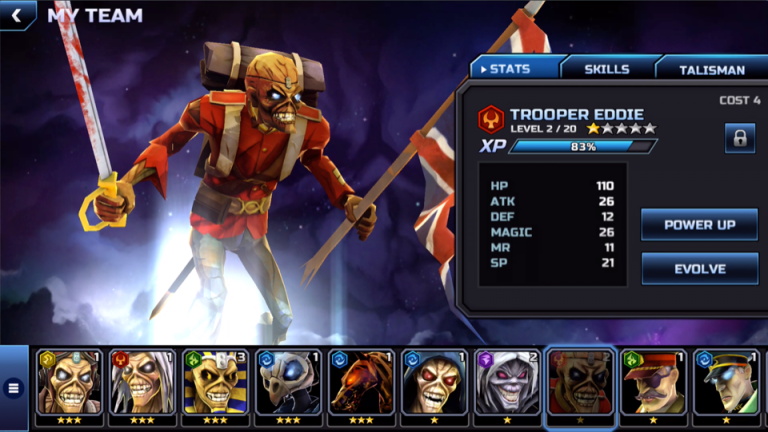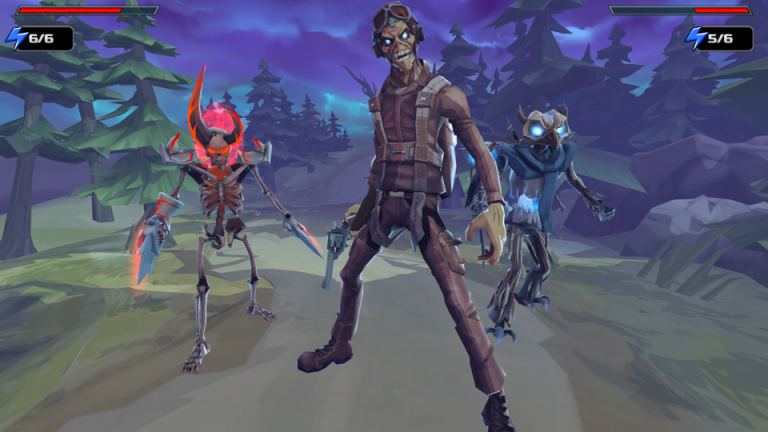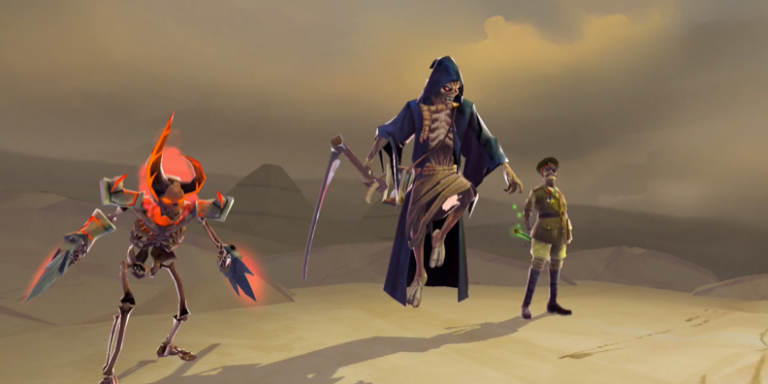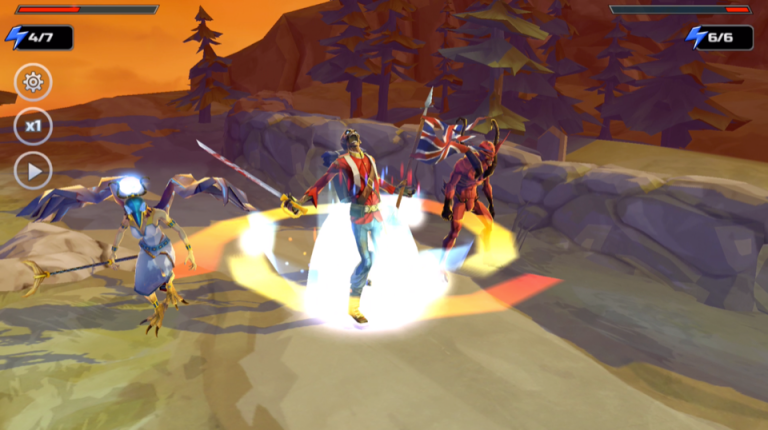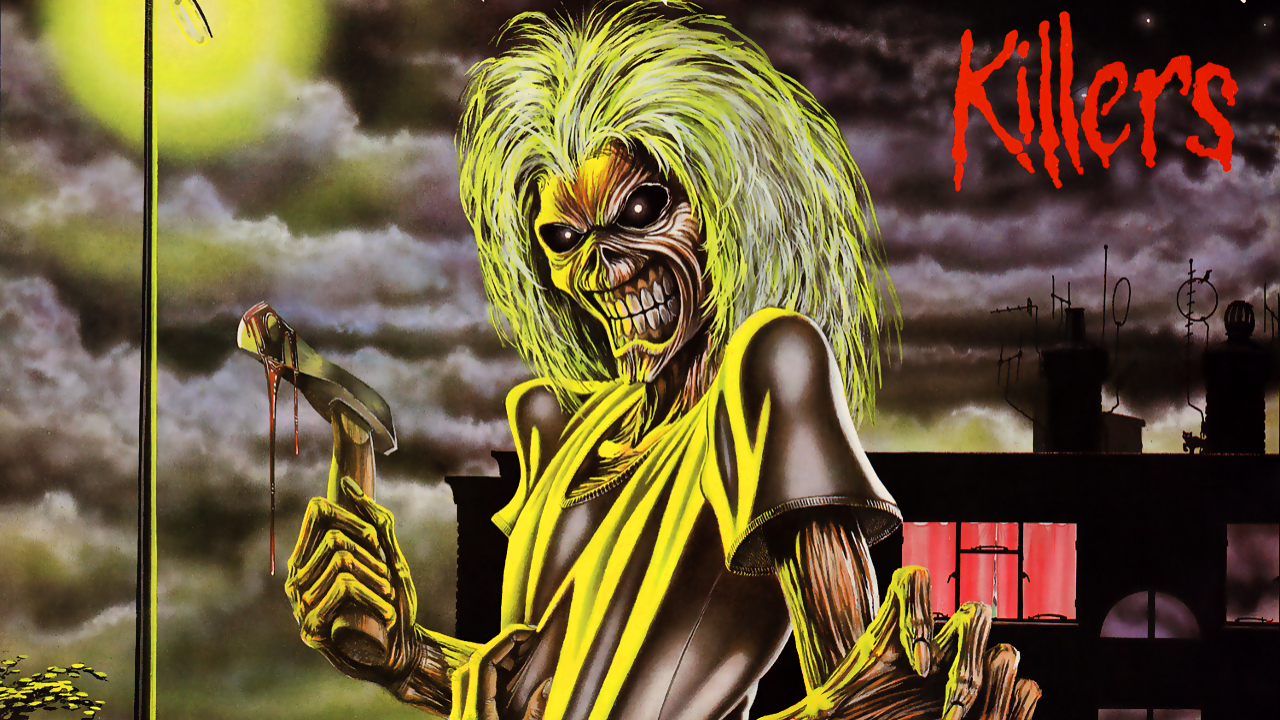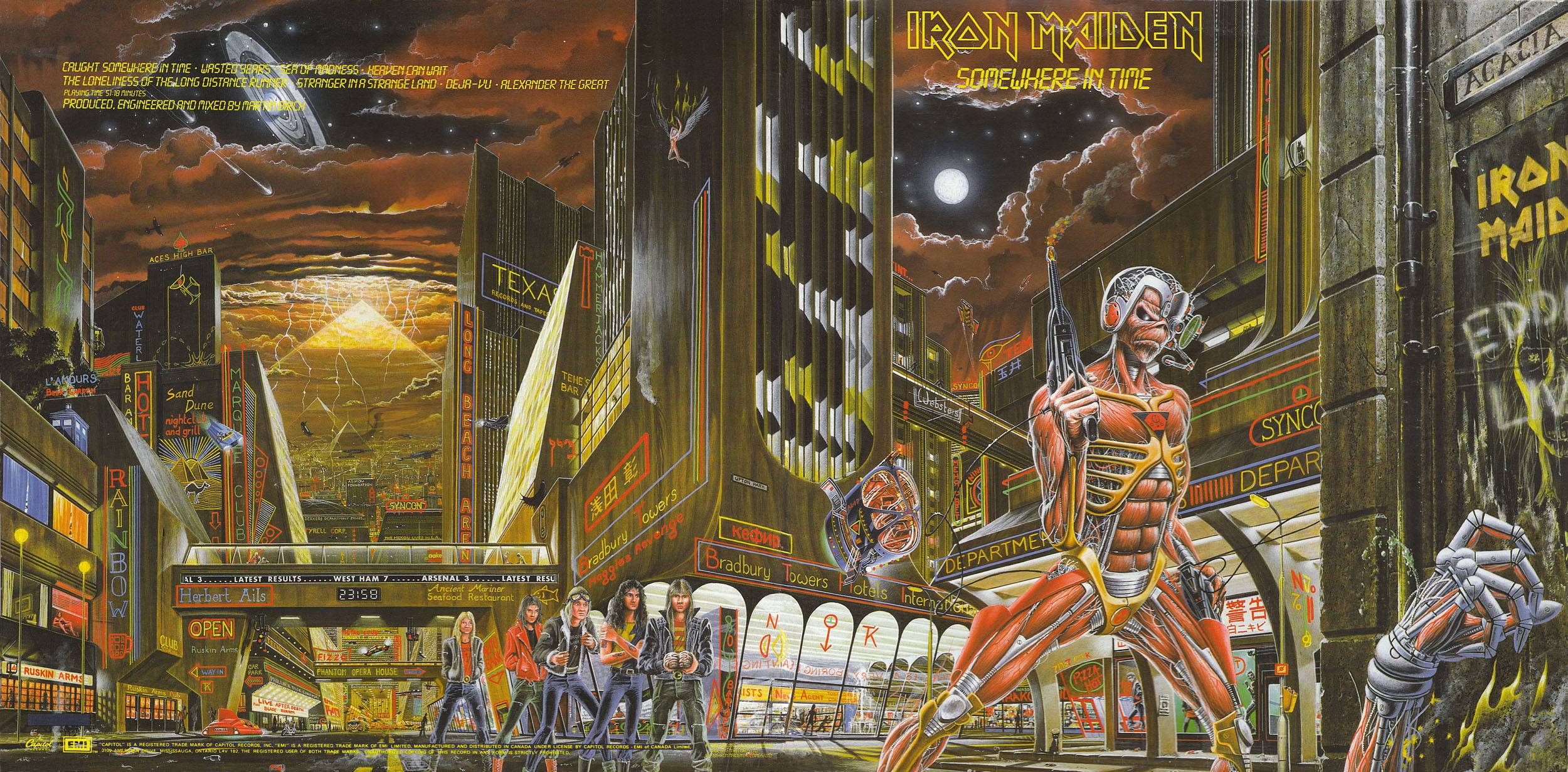Few bands could probably inspire a mobile role-playing game, but Iron Maiden has always been special.
Since forming in 1975, the heavy metal group has created 16 studio albums, including The Book of Souls just last year. It was the 10th best-selling metal album in 2015. In total, Iron Maiden has sold over 14 million albums worldwide. But fans have celebrated the band’s mascot just as much is its music. Eddie is a zombie-like creature whose appearance often changes. He’s been front-and-center on the cover of every one of Maiden’s albums. He also adorns nearly every Iron Maiden T-shirt. Now, Eddie’s traveling to the world of mobile with Iron Maiden: Legacy of the Beast. The game hopes to take advantage of a $34.8 billion mobile industry and potentially introduce the band to a new audience.
GamesBeat interviewed Llexi Leon, creative director for Phantom Music Management (which represents Iron Maiden worldwide) and Hamish Millar, director of the game at developer Roadhouse Interactive. We discussed the Legacy of the Beast, how it’ll incorporate Iron Maiden’s music and art, and why Eddie has become so popular.
GamesBeat: How did these two entities, Iron Maiden and your developer, come together?
Llexi Leon: I’ll try and keep a long story short. There’s a gentleman named Gavin Shackell. He’s a partner in a company called 50cc Games. He’d previously worked in the music industry as an executive at Virgin Records. He’d worked with Bruce Dickinson [Iron Maiden’s lead singer] and Rod Smallwood, Iron Maiden’s original manager and still manager today, many years ago. Then he moved into games and felt that Iron Maiden would be a great partner and property to work with for the games industry.
He reached out to us. We said it sounds cool, but we get a lot of offers for all kinds of things. We’d need to see your take on this and why we should do it. We should be compelled to do it for the right reasons, with it being a fantastic product. It turned out that Gavin knew James Hursthouse, the CEO at Roadhouse. James is a massive Maiden fan, an incredible knowledge of the band. They came to an arrangement and came back to us with a very detailed pitch with a lot of love that went into it, a lot of interesting takes on Eddie as a character, how they’d interpret that and interpret the world of Maiden.
That caught my eye, because at the time I’d been brought into the company to oversee some of the digital and interactive and new media creative. I said, these guys know what they’re doing and this is an interesting take on the character. It went from there. It was about six months to a year of back and forth over that and how we’d actually do it and what shape it would take before we knuckled down and did the business deal.
GamesBeat: What exactly is the concept that you settled on?
Hamish Millar: Initially we went through a number of stages in arriving at the concept. One of the starting points was that we wanted to tell the story of Eddie like it hadn’t been told before. We were looking for a format within mobile to flesh out his character and all the facets of Eddie throughout the history and lore of Iron Maiden.
Looking at mobile and knowing that we at Roadhouse are in the free-to-play space, we thought that the party battle RPG would be a great fit. We worked with the biz dev team here to establish that as our core genre. It worked really well, because if you look at the history of Eddie, he has so many different incarnations. That worked quite well in terms of turning each one of those Eddies into a different character.
GamesBeat: Is it a linear exploration of his history, starting with the original Eddie, then going to hell, then being lobotomized, and so on? Or is it all those different versions coming together at once?
Leon: There’s a certain mystique to Eddie. We wanted to preserve that. Even though we’re taking Eddie on a journey and telling a story with him for the first time, a lot of it is about looking at the mythology and a lot of the things you just referenced. Eddie when he’s lobotomized in the asylum, Eddie when he’s a cyborg, Eddie as a space monster, and all these different facets of Eddie and what he has been, is, and will be. Trying to condense that down into a cohesive narrative where we’ve created something new in order for there to be an Eddie that encapsulates all of these things.
So it’s not, to answer your question, a linear tale that tries to tell the story as the albums came out, what was happening to Eddie between these times. It’s a new overarching mythology, but with a lot of details going into it to bring in all of these different imageries from the tour shirts, the event shirts, the tour posters, the album art, the single covers. We’ve looked at everything across four decades of the band’s history and tried to create a new overarching tale that brings that all in and gives it a reason for existing within the context of this game. We want to bring as many of those different Eddies to life as possible, but the way the game is set up is that really they come from all the same Eddie, this Eddie Prime if you will.
A big part of the story, without giving too much away, is that in the beginning, a malevolent force kind of tricks Eddie and shatters his essence and scatters it across the universe. Each piece of his essence represents a different facet of Eddie, one of these different versions of Eddie you would have encountered on your favorite event shirt or album cover.
GamesBeat: Do you guys look at any other RPGs for an influence on this game?
Millar: Yeah, absolutely. We’ve been fairly original in terms of art style. I’d say the one area that we really needed to take influence from was just in terms of the RPG metagame in the mobile space. We want this to be a game that players will play for months and months, not a short set story arc that’s over. That’s more akin to a premium product.
Some of the games we’ve been looking at in terms of benchmark metagame would include Contest of Champions and Summoner’s War. Both of those games do an incredible job of giving the player long and compelling upgrade paths for the characters and reasons to build different teams of characters for different purposes in the context of the metagame.
GamesBeat: This is a free-to-play game, so what kind of things will people be able to buy?
Millar: We understand soft and hard currency. But within that context people will be purchasing XP boosts and largely running through a gacha system, where players will be collecting souls as they navigate the worlds of Iron Maiden. Souls can be purchased or collected. That’s where the character collection comes from in the game.
There are Eddies that will be familiar to Maiden fans, for sure. Those will be the rare and valuable characters. But we’ve worked with Legacy to expand the lore of Maiden and invent all these other fascinating characters that we can imagine populating the worlds familiar to Maiden fans from the album covers and tour posters. We’re looking at roughly 200 characters at wide launch. Dozens of Eddies and over 100 supporting characters.
GamesBeat: Will the band members themselves be appearing in the game?
Leon: No. We decided — it’s very much all about Eddie and exploring the worlds that Iron Maiden have created with both their lyrical output, the songs themselves, and the artwork. We’re bringing that to life. The band members aren’t part of that. But their music is a huge part of it. That’s something that — a huge amount of work has gone into re-creating a lot of the music for the game. Long-time fans of the band are going to be excited to hear a lot of previously unreleased recordings of iconic songs from the current band’s lineup that we’ve specially tailored for this production.
GamesBeat: So you’ll be using actual Maiden songs as the soundtrack?
Leon: The soundtrack is expansive. It contains tracks from across the band’s entire history, a huge number of tracks and ever-expanding. The way we’ve tried to incorporate them thematically is that there are worlds in the game, which speaks back to how the main narrative plays out — there are worlds within the game, four at wide launch, and each world is an amalgamation of different Iron Maiden tracks with similar thematical content.
You think about a track from, say, Brave New World, like “The Nomad,” and then a track like “Powerslave.” They’re both set in the desert sands and ancient Egypt and all of this, so we have a world in the game called Kingdom of the Sands that encapsulates all that good stuff. Obviously the soundtrack is appropriate to that.
GamesBeat: Was it a fun thing to sort of go through all these songs and try to pair them up by theme like that?
Leon: For me it’s the ultimate geekout, having an excuse to listen to nothing but Iron Maiden nonstop for six months, trawling through all the liner notes and the gatefold vinyl stuff. We have something called the Iron Maiden companion, which was compiled by an Italian megafan about 10 years ago. It’s a 400-page compendium of every single piece of tour artwork and shirt artwork and album or single variant artwork he could get his hands on going over about 20 years of the band’s career. Then he followed up and did a volume two that had another 10 years of stuff.
Looking at all this imagery and all the lyrics and all the music and trying to piece it together thematically, seeing what works where and how we can build worlds and narrative out of this stuff. Things, for me, that have been really rewarding seeing it come together — taking concepts, and in some cases things like the Wicker Man, and making that into an actual character and part of the story, how Eddie interacts with that character. And also iconic characters from Maiden history like the Ancient Mariner, which obviously has a deeper history beyond Maiden in the literature that inspired that song. And then we’re looking at both Maiden’s interpretation and the actual poem and drawing from both of those things and bringing that character into the world. There’s a lot of exciting stuff like that in the world-building that’s been thrilling for me.
GamesBeat: I was going to specifically ask you about both of those songs, so that’s awesome.
Leon: It’s all coming. There’s a lot of content at launch, and we have a long-term schedule to bring in more. We’re just starting with these four worlds. As you can imagine, the worlds of Maiden that have been touched on are quite broad. There’s a huge amount we can do in the future as well.
GamesBeat: Other bands have had mascot characters, but it seems like Eddie has sort of transcended the mascot role. He’s become something more. I don’t know exactly what you’d call it. But why do you think Eddie has resonated so well over the years?
Leon: From my point of view, a lot of people initially — I remember as a teen being drawn to Iron Maiden by the album art first. You’d heard of the band and you’d see Eddie on people’s T-shirts or on the cover of Metal Hammer and instantly you’re just like, that’s really damn cool and I want to know more about that. A lot of people, that was their first exposure to Maiden, through Eddie. They were drawn to the band because of the character.
But in terms of why he’s transcended that role, I think it’s because the band, they’ve never really put themselves in the spotlight. It’s always been Eddie. There are very few bands that, over 16 studio albums, have their mascot, if you will, take the spotlight on every cover and every tour poster. Whenever they go to different countries they do these themed versions of Eddie, so as well as the iconic album ones, you then have Viking Eddie or samurai Eddie that’s come about from the band going to those territories and wanting to bring Eddie with them. He’s obviously become part of the live show, so all of a sudden you have a seven-foot cyborg on stage battling the band. This is something unique to the theatrics and imagery of Iron Maiden.
The game, because of the mystique around Eddie, he’s sort of all things to all people. Or he can be a lot of different things to a lot of different people. That’s fascinating as well, because he isn’t this archetypal hero character, or even an anti-hero. He has so many different guises and so many different roles that people gravitate toward him for different reasons.
That, to me, is probably the thing that’s most exciting about Eddie. You can’t put him in a box and say, this is what he is. You can get a huge amount of feedback from the fans about what Eddie is to them, and then we can try and act on that and allow the fans to tailor Eddie to what they want him to be based on all the things he has been.
Millar: To add my perspective, first and foremost, Maiden has the coolest shirts. Most of the metal bands I’ve seen interviewed that have been asked about that will agree. Because it was working so well, I think the band just continued with it. If you look at some of these other bands that have grown and changed over time, there’s a difficult balance to strike between growing and changing and still maintaining a sense of cohesion.
Eddie seems to be that conduit for Iron Maiden. They can branch out and change and experiment, but it’s all sort of anchored in Eddie, whether it’s the live theatrics on stage, the album art, or tour posters and localizing those just as Llexi pointed out. In many ways he’s this conduit through which all of the band’s experimentation gets pushed, and he ties it all together really well. It’s really cool.
GamesBeat: You were talking about how part of Eddie’s appeal is how he can be different things to different people. He doesn’t necessarily have a set personality or anything like that. Does that make it challenging when you try to adapt the character into something like a game?
Leon: You have to treat him with the reverence he deserves. There’s certainly an attitude and an energy to Eddie that comes through in almost all the imagery I’ve ever seen of him. We try to capture that. The decision was made early on that Eddie’s kind of a primal force, almost a force of free will. He’s not necessarily a character that articulates in English or has verbose conversations. We went with what I refer to as the “hero of all of time” approach, which is fitting given his predilection for time travel.
The story is driven forward by the characters around Eddie that he interacts with. Eddie doesn’t actually converse directly. So we maintain this mystery around him, which I think is pivotal to his character. In his case, it’s about what he does, not what he says.
Millar: We have that challenge there, where you do want to leave him open enough that people who are playing the game can project themselves onto Eddie and identify with him. But the more specific you make him, it’s a bit like when Final Fantasy [X] gave Tidus a voice. Suddenly they lost some people and their connection to the main character.
For the most part he’ll be a silent protagonist. But at the same time you’ll see him go on his own character arc over the game. While it doesn’t follow any linear fashion, the exact part that Eddie’s taken throughout the history of the band, you will see some parallels. One of those would be, when you look at when Iron Maiden first started as more of a punk band, more aggressive — you look at the Killers cover, for example. As the band matured and they started — the pure aggression became intertwined with larger questions about life, what is real, what is right, what is wrong, what is here.The clairvoyant Eddie, the Seventh Son Eddie, almost transcending the initial state that Eddie began in.
You’ll see Eddie change and grow throughout the game in parallel with that. Starting out as perhaps more of a pure revenge motivation and then really starting to ask larger question in terms of, what is this plot that’s starting to unravel? Perhaps it’s actually bigger than Eddie himself. Maybe Eddie has a greater purpose in the game.
GamesBeat: Do you guys have a favorite version of Eddie yourselves?
Leon: For me, it’s kind of an amalgamation thing. I really like Holy Smoke Eddie, the classic Eddie with the white hair and the leather jacket. That’s why, when I got the opportunity to that bit of live video, I immediately went for him being the archetype — ripped jeans and a T-shirt and a leather jacket, that very classic look. But they’re all just fantastic. There are a few cool new ones we’re doing as well. One I’m working on right now I’m very psyched about, but I can’t talk about it.
Millar: The answer to that question has been somewhat influenced by working on the game. Some of the Eddies really show well in our game engine. Somewhere in Time, the cyborg Eddie, has become my favorite as a result of looking at him and playing with him in the game.
GamesBeat: Cyborg Eddie is the right answer. [Laughs] Somewhere in Time was my first Iron Maiden album, so that’s always the one I’ve loved the most. Do you guys have a target release date for this?
Millar: We do. We’re planning on soft launching the game toward the end of March within a small set of countries. That list hasn’t been confirmed. We’ll be rolling out into a wide launch in the next few months following that. More details on an exact worldwide launch will be forthcoming.
VentureBeat's mission is to be a digital town square for technical decision-makers to gain knowledge about transformative enterprise technology and transact. Learn More
